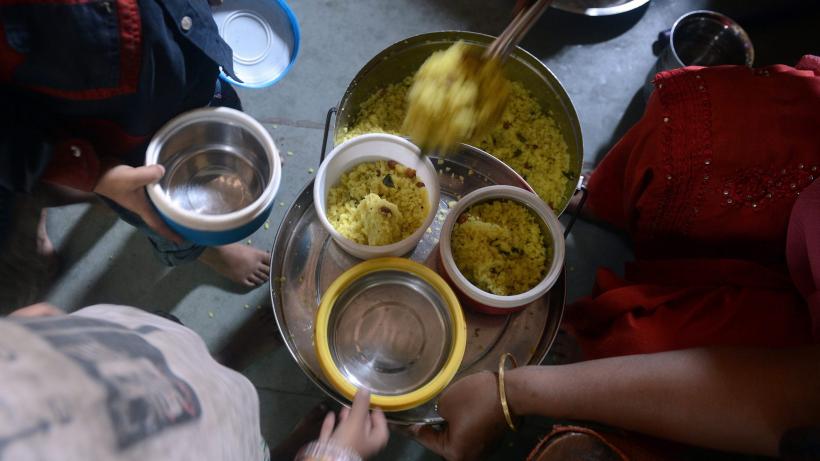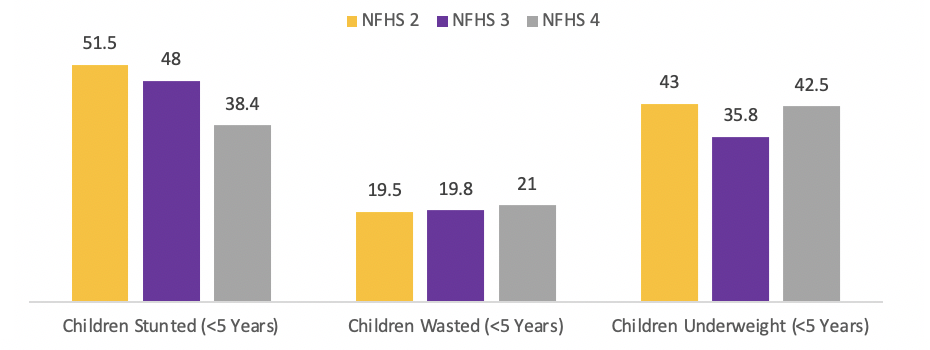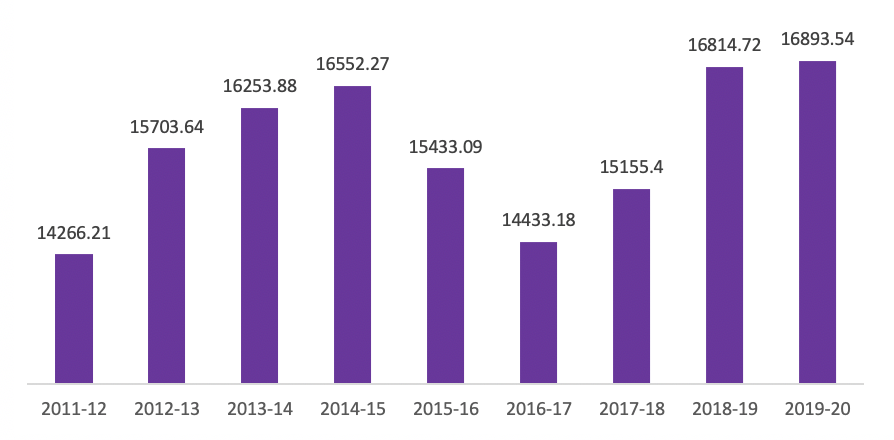
Nutrition in India: A look at the policy Initiatives, investments, and outcome indicators
With an aim to decrease malnutrition, India has implemented several nutrition interventions in the last half century, including the National Food Security Act 2013, NIPCCD, ICDS and the mid-day meal scheme. Even with strong constitutional and legislative policy, plans, programme commitments and institutions, as well as a spurt in GDP growth, dietary diversity and malnutrition have not improved. The Indian government needs to strengthen food systems, nutrition finance, and health systems to effectively tackle malnutrition.
While addressing the World Economic Forum in 2018, the Prime Minister of India, Narendra Modi, shared his aspiration to make India a US$ 5 trillion economy by 2025, which seems inconceivably ambitious with 38.4% of India’s children under the age of 5 stunted and 35.8% underweight . India has committed itself as a stakeholder to End Hunger (Goal 2) by 2030, as part of the Sustainable Development Goals (SDGs). However, with current trends as per the Global Hunger Index (2020), India ranks 94 out of 107 countries. Apart from that, as per the Global Nutrition Report (2020), India is likely to miss global nutrition targets by 2025, which also seems to align with the data released from the 1st phase of the National Family Health Survey(NFHS)-5 Data. The 1st phase results of NFHS-5 received nationwide attention, which shows that child nutrition indicators have not improved between 2015-16 and 2019-20. The results are alarming because in most states, indicators such as childhood stunting, wasting ,and proportion of underweight have worsened. For tackling the issue of malnutrition, the Government of India (GOI) launched the POSHAN Abhiyaan and claimed that the fight against child malnutrition is one of the priorities of the government; however, in reality, even after the recommendation[1] of the 15th Finance Commission on Supplementary Nutrition Programme (SNP), the Ministry of Finance rejected the commission’s recommendation, which shows that malnutrition is not the priority of India’s development agenda.
India’s nutrition status and policy scenario – blatant gap: Over the last 45 years, India has implemented several nutrition interventions with the aim to decrease malnutrition. With the formulation of Integrated Child Development Services (ICDS), and the nationwide execution of the mid-day meal scheme and the National Food Security Act (2013), India has aimed at improving the country’s nutritional situation. Apart from that, the GOI launched several other schemes to nurture women and children’s health, including the POSHAN Abhiyaan, Anganwadi Service Scheme, and the Pradhan Mantri Matru Vandana Yojana (PMMVY) under the ICDS. However, undernutrition and stunting still persist as roadblocks for the country. India is the home to almost one-third of all the world’s stunted children and half the world’s wasted children. As per the NFHS-4, wealth quintile analysis gives us a further grim picture – half of all children from families in the lowest income quintile are still stunted or underweight. While India has made sustained rapid
Figure 1: Malnutrition Trends

economic growth, and great strides in becoming an economic superpower, the nutrition scenario has remained discouragingly stagnant till now, with extremely slow rates of improvement and a continuing high burden of undernutrition. Child malnutrition is currently responsible for 15% of the total disease burden in India and currently costs India as much as 3% of its gross domestic product (GDP) per year, which is around US$ 46 billion.
Concerns despite growth and investments to improve nutrition outcomes: Even with strong constitutional and legislative policy, plans, programme commitments and institutions, including the National Food Security Act 2013, NIPCCD and ICDS being put in place by the GOI to prevent malnutrition, India is still not able to tackle the challenges of malnutrition. As per the Central Government Budget, ICDS spending has only increased marginally, by INR 341 crore over a 6-year period between 2014-15 and 2019-20. As per the Accountability Initiative, the approved budgets for SNP only accounted for 44% of the total required amounts in 2019-20. Moreover, the amount allocated for Umbrella ICDS decreased by INR 432 crore, which in real terms implies that the allocation for CORE ICDS is more or less same today than it was six years ago. Additionally, the central budget for mid-day meals (MDM) was 11051 crores in 2014-15 and in 2020-21, it was INR 11000 crores which is lower than what it was in 2014-15. Poshan Abhiyaan, the GOI’s flagship programme to address the issue of malnutrition, has a tiny budget of 3,700 crore, and only 37% of funds released by the GOI between 2017-18 and 2019-20 were spent until December 31, 2019; 36% of the total expenditure of Poshan Abhiyaan is on the ICT – real-time monitoring, while over 30% of supervisory positions in ICDS remain vacant. While this flagship programme has managed to create a buzz around malnutrition, most of the structural issues still remain neglected.
Figure 2: GOI Spending (Actual) on ICDS (Anganwadi Services)*

*In crore. Source: Union Budget
GDP growth was 8.5% per annum during 2004-12 as compared to 6.3% per annum during 1993-2005. Between 2005 and 2016, there was a decrease by almost half in terms of multidimensional poverty, which reduced to 27.5%. It is noted that if we look at consumption-based poverty or MPI, poverty declined faster during the high-growth period; however, the increase in GDP was not able to address the issues of malnutrition and dietary diversity. Evidence suggests that the average daily calorie consumption in India is below the recommended diet for all groups, barring the richest 5% of the population; 63–76% of the rural poor could not afford a recommended diet in 2011. The Comprehensive National Nutrition Survey (CNNS) also stated that the dietary diversity and frequency of meals is actually not good: 42% of children aged 6-23 months were fed the minimum number of times per day for their age, 17% received minimum dietary diversity and 6% received a minimum acceptable diet. Though India has nearly 56 million tonnes of excess stock of grains and cereals compared to the usual norms, there is a need to diversify production towards nutrient-rich foods to improve dietary diversity and nutritional status.
Urgent actions to achieve nutrition targets: For the last couple of years, economic slowdown and stagnation in wages, the growing food-insecurity amongst poor households, inequality in access to diverse diets, and insufficient investments in welfare programmes, has led India to an alarming situation where the GOI needs to revisit or rethink malnutrition. This was reflected in the results of the consumption expenditure survey of the NSO (2017-18) which were leaked in the media and later scrapped by the GOI citing data quality issues. We should also note that the first phase of NFHS-5 data shows the situation just before the COVID-19 nationwide lockdown and there are chances that within the last one year, child nutrition has worsened further and urgent actions are therefore needed. Malnutrition is a multi-dimensional problem and the suggestions for the GOI would be to prioritise three key areas:
- Food systems: The GOI should implement strong regulatory and policy frameworks to support healthier diets for all and should address the political economy of food. It is said that bio-fortification is one of the more cost-effective solutions to provide the desired levels of nutrients. Measures to ensure effective implementation and integration into policies, consumer demand and access to food needs to be prioritised.
- Nutrition finance: The GOI should proactively develop new financing mechanisms that can complement existing sources and accept the recommendations of the 15th Finance Commission. Nutrition inequalities exist across states as well as within communities. Therefore, decisions on resource allocation should be informed by data through evidence-based and cost-effective solutions. Apart from that, the reviving and universalisation of MDM would be a good start.
- Health systems: The GOI should roll out nutrition services within health services by developing cost effective nutrition care plans, and should invest in human resources for access to quality nutrition care. It is also crucial to create a comprehensive approach that will address the different sectors and dimensions of nutrition. Community-driven initiatives, Village Health Sanitation Nutrition Day (VHSND) and the Community-based Management of Acute Malnutrition (CMAM) model need to be strengthened. Evidence does suggest that large numbers of children with severe acute malnutrition can be treated in their communities without being admitted to a health facility or a therapeutic feeding centre.
Disclaimer: The views expressed in this post are those of the authors based on their experience and on prior research and do not necessarily reflect the views of the IGC.
[1] In its interim report, the commission stated that “malnutrition of infants is a human capital issue that cannot wait to be addressed. Hence, we have made an exception in the case of the nutrition sector by giving it a grant of Rs. 7,735 crores in 2020-21 itself”.

